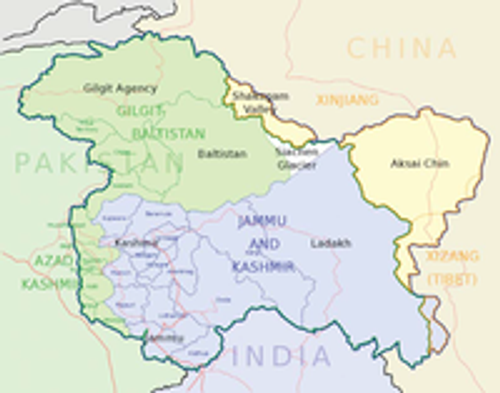Cashmere - Don’t Let it Get Your Goat!
Posted by Kim Brooks on 3rd Apr 2014
I have found it very exciting to learn and write about Cashmere. As everyone knows, cashmere is soft and luxurious and we are always comparing alpaca to cashmere, so I was eager to get the whole story.
For this article, I called a handful of friends and relatives and asked them, “Do you know where cashmere comes from?” Just to be clear, this is not a research study. My aim is to see what people thought and to gage the understanding of cashmere by the consumer, admittedly a small sample, which explains a lot about my gene pool, but I digress.
Here goes.... One person said, “I was told that cashmere came from cashmeres and they were rodent-like animals similar to mink.” Really? A few folks said that cashmere was from “rare mountain sheep from China.” Better, and closer to reality. Then I got “cashmere is a very expensive man made fiber.” More truth in that than most folks believe, but more on that later. I did get that cashmere came from “Cashmere Goats”, close but not completely accurate. And lastly I received the answer “Who cares! Its just wonderful!”
Hummm.... So what is cashmere, really?
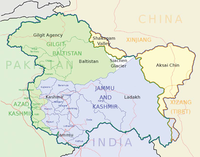
Cashmere is one of our oldest textiles. Ever since the 3rd century BC, Pashm (Persian for wool) or Pashmina, was known for its use in Kashmir shawls. This wool was harvested from goats, one of the oldest domesticated animals. Used for meat and milk, cheese and wool they were the sheep of the region, having to live in wildly diverse climates and regions. The textiles from these goats are mentioned in writings from as early as the 3rd century BC to the 11th century AD.
The real birth of the modern cashmere came from the 15th century ruler of Kashmir who introduced the weavers of Turkestan to this wool. In the 18th and early 19th centuries the region of Kashmir was ruled by the British. (Kashmir lies to the south of the Himalayas and is the northern-most tip of the peninsula of India. It was influenced by Pakistan, China and Indian and often ruled by them as well.) The British called this area Cashmere. It was known for its thriving industry of producing shawls from goat down imported from Tibet and Tartary. One of these shawls was sent to France and immediately created quite the sensation. From there, the rest is history.
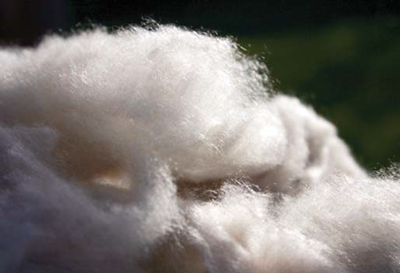
Pick up a modern fashion magazine, especially in the Fall, and you will see references and advertisements for cashmere sweaters, socks, suits and shawls... all costing a lot of money. Historically, the demand for these items has remained steady through feast and famine, war and peace. This is because of two factors: First, the wonderful feel and the low bulk of the yarn used to make these goods. The second is a price point that clearly gave Cashmere a privileged status. For decades Cashmere was known as the warmest, softest and most comfortable garment money could buy and was reserved for the social elite.
Cashmere comes from goats?
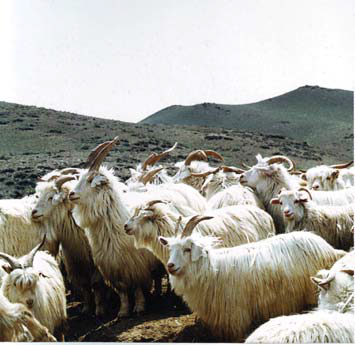
The two most common fibers produced from goats are mohair and cashmere. Angora goats produce mohair. Cashmere is a fiber type from a goat, not a breed. The Cashmere Association specifies that: “Cashmere comes from any type of goat, other than Angora. (Capra aegagrus hircus)” There is no such thing as a Cashmere goat, however the breed of goat considered or referenced as “cashmere” (Capra hircus laniger) have been selectively bred over centuries to produce more of the soft fleece or goat down, than the other, more common species.
Cashmere fiber is crimped (rather than wavy), soft, and lacking luster. It is also smooth, resilient and moisture absorbing. This high moisture content allows insulation properties to change with the relative humidity in the air.
While white is the most desired, cashmere is also found in brown and gray shades. One animal can produce up to one pound of fiber with the average of four to six ounces of down.
Prices paid to the farmers vary between approximately 16 US$/kg in Afghanistan and up to 23 US$/kg in Mongolia. (A kilogram is equal to 2.2 lbs..) These numbers, the only ones I could locate with any accuracy, were from 2006. Again these numbers depend on the quality and the expected yield of white only fiber. Colored fibers bring considerably less.
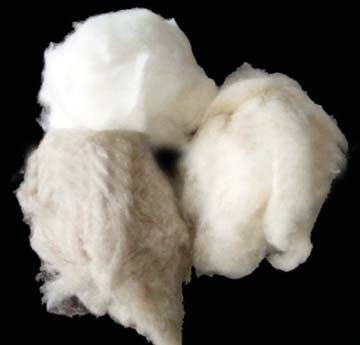
Goats can be very well utilized. A goat enterprise offers producers the choice of selling fiber as well as meat. The soft down is used in textile production while the course guard hair is used to make brushes, interlinings and other non-worn apparel.
The countries currently producing the largest amounts of cashmere are China, Mongolia and Tibet. Today, little is supplied by the Kashmir province of India. Other significant supplier countries are Iran, Afghanistan, Russia, New Zealand, and Australia. The US imported goats from Australia in the 1980s but little information is available on production volume and comparatively does not make an impact in the global arena.
The fiber is shorn or brushed from the goats during the molting season, being the product of a winter coat. This fleece grows to protect the goats from the harsh climate and is shed, or molted, in the spring. It is a double fleece, consisting of a very fine crimpy undercoat mixed with a very straight coarse fiber, known even in the cashmere industry as guard hair. The fleece can be obtained from any part of the body, even though certain reports say it is only gathered from the underbelly or chin area. This has thought to be spread so as to add more rarity and mystique to this fiber.
The fleece of the goat needs to be dehaired. Up until the late 1970s this process was done by hand. In 1978 the first commercial dehairer was invented, increasing the ability to yield greater volumes of the down than ever before.
The US Wool Products Labeling Act of 1939, as amended, (U.S.C. 15 Section 68b(a)(6)) defines cashmere as:
“A) the fine (dehaired) undercoat fibers produced by a cashmere goat (capra hircus laniger);
B) the average diameter of the fiber of such wool product not exceeding 19 microns; and
C) containing not more than 3 percent (by weight) of cashmere fibers with average diameters that exceed 30 microns. The average fiber diameter may be subject to a coefficient of variation around the mean that shall not exceed 24 percent.”
Cashmere has three grades as set out in the chart on the next page.
The long fibers are used in knitted garments while the shorter cashmere fibers go into woven fabrics. The fiber diameter must be less than nineteen microns to be classified as cashmere. The typical range of cashmere is sixteen to nineteen microns. Often plies are referred to when talking cashmere. The best ply is two ply and additional plies, add only cost and not quality to the garment.
Is cashmere rare?
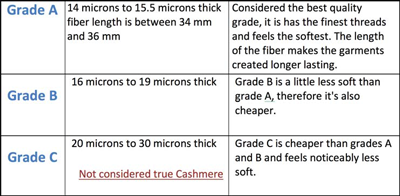
China leads the world in cashmere production and consumption, but that shouldn’t be surprising. Looking at apparel as a whole, China exports an estimated twenty billion finished garments a year, more than three pieces of clothing for every person on Earth.
Official livestock production statistics appear to be gross underestimates. The provincial regional governments in Asia levies a head tax on livestock, which discourages villagers from declaring all their animals to tax collectors. This applies particularly to goats, which the authorities consider are ecologically damaging, tearing up native grasses, eating bark and killing trees. Their hooves so sharp they break the soil, allowing for erosion and now, frequent dust storms. Because of these ecological factors a higher tax is levied on goats than on sheep, so the farmers report false and reduced inventories. Unofficial head counts seem to confirm this and estimates are perhaps three to five times the official statistics.
"I would never have imagined," Colleen Young said standing next to the plasma TVs at a Costco in Chicago. “that Costco moved 18 per cent of the world's consumption of cashmere in 2001 - more than a million sweaters - but they did.”
Andy Bartmess, chief operating officer of Scottish cashmere producer Dawson International, said, "Cashmere has a hundred-plus-year history as a luxury product. The last few years have begun to destroy that reputation."
In less than a decade, a deluge of cheap cashmere from China has transformed a centuries-old industry, stripping the plush fabric of its pricey pedigree and making it available in big-box America. Chinese-made cashmere sweaters now go for as little as $19.99. In the case of cashmere, America snapped up a record 10.5 million Chinese sweaters in 2009, fifteen times as many as a decade ago, and far more than every cashmere sweater imported into the US from Italy and the United Kingdom, combined in the same time frame.
The trend seems to have no end in sight. Exports of cashmere and cashmere finished products increased more than a third in the first half of 2011 and the organizers of the Cashmere World Trade Show, concluded in late October just days prior to this writing, say the future continues to look bright.
How does alpaca compare to cashmere?
First, Cashmere people love that everyone compares other textiles to cashmere. They say it sets the bar high and is a great marketing tool (for cashmere) that every fiber strives to be just like it. I think alpaca leaves cashmere in the dust for a number of reasons.
From a micron standpoint alpaca is slightly more coarse. However, it’s the length of the fiber that makes it stand out against cashmere. The length allows for the creation of garments that are stronger and more durable than cashmere. Cashmere products, from socks to knits, wear holes in the footpad or in the elbow area because of the delicate fiber.
Alpaca has a natural luster making it outshine the dull fuzz of cashmere. Because alpaca can be made into various gage yarns, everything from fine lightweight knit to bulky sweaters can be achieved. Cashmere sweater are generally fine gage only, because of the cost.
Alpaca is easier to clean and stays cleaner longer. Woven cashmere garments require dry cleaning while knit pieces can be hand washed, but it is not recommended. Cashmere garments require cleaning more frequently than those made with alpaca because cashmere can absorb body moisture. This causes it to become more dirty and retain external odor. Moths love cashmere and a dirty sweater will attract moths readily.
Cashmere companies claim that Grade A cashmere doesn’t pill; I beg to differ. I have yet to meet a cashmere garment that didn’t. This pilling cuts down on the life span of the sweater, making it look old in a relatively short time. Alpaca sweaters far outlast even the finest cashmere.
Cashmere claims to be warm, yet it can’t hold a candle to the insulating characteristics of alpaca. With its water absorption, cashmere can hold up to 15% moisture whereas alpaca doesn’t absorb at all. It wicks the moisture from between the fibers, moving that moisture away from the body creating a more comfortable environment for the wearer. The biggest problem facing Cashmere are fakes and fraud, and cashmere shares this problem with alpaca.
In checking out available cashmere alpaca blends I found information on mislabeling, a huge problem in cashmere and a growing problem in alpaca. It has become apparent that many of the garments being sold in the USA claiming to be genuine cashmere, in reality, were not. We have seen this in alpaca as well. Check around online and you will find alpaca listed as a “color” so that they are pulled by search engines, (Chicos online store), alpaca sweaters being sold by name “ X Alpaca Sweater” and containing only 10% alpaca (too numerous to mention the retailers), or my favorite, “Katherine Barclay Touch of Alpaca Sweater” which is 75% acrylic, 10% wool and 10% alpaca, just to cite a few examples.
This is important because it shows that more people are looking for alpaca and retailers are taking note and marketing to them. This has been going on for years in the world of cashmere.
The problem of mislabeled cashmere, alpaca and other natural fibers has tarnished, and continues to tarnish, the reputation of the product itself. The problem is aggravated by the companies who make and sell the garments, because they (the garments) do not perform to the customer’s expectation and create ill will for the product.
The increased competition and demand for fiber has resulted in increased product contamination. Sheep wool is being blended with dehaired cashmere and the fibers are being sold as 100% cashmere. The same thing is happening with alpaca. These fibers are being sold to Chinese yarn makers and sweater mills, as well as to Western buyers. As a result, more mislabeled garments are expected to be found in retail stores. Here is that “man made cashmere” we touched on earlier.
Cashmere and alpaca share the fact that they are both expensive luxury fibers. This offers a great incentive for unscrupulous manufacturers and vendors to cheat on the amount of the fibers in a garment.
What can you do?
Become familiar with the real thing. Watch out for so-called bargains and look for genuine quality behind the label. Look for products with the IAA, International Alpaca Association branding on them, stating that they qualify under their branding program.
When shopping for alpaca garments, check the loop or side seam labels and hang tags for the fiber percentage. Sometimes retailers use sleeve hang tags or names that read Alpaca Blend or "Alpaca", but the garments only have a tiny bit of alpaca in them.
Not carrying a statement of actual fiber percentages is a violation of the Wool Products Labeling Act, enforced by Federal Trade Commission. It is also deceptive advertising. It is important that retailers are alert to this problem, because both federal and state laws hold retailers responsible for the accuracy of the label information on the garments they sell.
The Wool Products Labeling Act http://www.ftc.gov/node/119457 protects consumers and manufacturers from deceptively labeled wool fabrics and mislabeled wool garments. This Act, enforced by the Federal Trade Commission's Bureau of Consumer Protection, requires the following labeling information be displayed on any garment labeled as containing wool or fine animal hair:
- Wool products must be labeled in order of predominance with the percentage of total fiber weight of wool, recycled wool and each fiber other than wool, which is 5% or more. If a garment contains a minority percentage of a fiber such as cashmere, for example, it is unlawful to feature the word "cashmere" or “alpaca” in such a way as to mislead the consumer by suggesting that all or a majority of the garment consists of that fiber.
- When a generic name or a fiber trademark is used on any label, complete fiber content disclosure with percentages of all fibers present must be provided on that label.
- The country of origin of the garment must be stated and, if made in the USA of imported fabric, the label must so state.
- All information must be in English.
- The word "all" or "100%" can be used
with the correct fiber name when the
garment is composed of one kind of
fiber.
- A label must be visible and securely affixed to each wool garment and must remain on the garment until sold to the consumer.
With regard to blends, I found some baby alpaca cashmere yarns clearly marked and available. I also found some finished goods available at exorbitant prices. What I found in greater quantities was wool; to be specific, sheep’s wool with a tiny bit of both alpaca and cashmere, marketed as Cashmere/Alpaca.
Six years ago I did a blend of baby alpaca 43%, cashmere 43%, acrylic 10% and Lycra 4%, thinking that it would be lovely. The garments felt like heaven the first time I wore them. Then each time thereafter, for about four wearings, they grew thinner until they had to be thrown away.
Today, I don’t think an alpaca cashmere blend would be lovely at all. “Why not?” you ask. Wouldn’t the cashmere soften the handle of the alpaca? Wouldn’t the alpaca add the strength and durability to the cashmere?
No. By diluting both you aren’t doing either fiber justice. Each can stand on its own as a pure fiber that produces fantastic 100% garments, with their own unique characteristics. However, when they are combined you do not gain anything. The shortcomings of cashmere take away from the alpaca properties. The cashmere detracts from the luster and ease of care of the alpaca and all it’s wonderful properties. It might be a great marketing ploy, but from a practical standpoint, on the side of both the cashmere and the alpaca, as well as that of the consumer, it simply doesn’t make good sense.
So, the next time you think about comparing alpaca to cashmere, Stop! Instead compare cashmere to alpaca and feel confident about it!
Resources:
http://boutiquejewels.com/cashmerefaqs.html http://underwritersusa.com/Collections/cashmere- whatis.aspx http://boutiquejewels.com/cashmerefaqs.html grades-cashmere.html http://boutiquejewels.com/cashmerefaqs.html grades-cashmere.html#ixzz1c7EY08ox http://boutiquejewels.com/cashmerefaqs.html mere-industry.php http://boutiquejewels.com/cashmerefaqs.html k/goats/goats_for_fiber.cfm http://boutiquejewels.com/cashmerefaqs.html http://www.ftc.gov/os/statutes/textile/woolact.ht... http://boutiquejewels.com/cashmerefaqs.html 03498352_cashmere282.html http://boutiquejewels.com/cashmerefaqs.html
[PDF] Wool and cashmere www.fao.org/docrep/012/i1283e/i1283e01.pdf www.fao.org/docrep/012/i1283e/i1283e01.pdf http://www.ddsclub.com/wordpress/2011/05/chinas- cashmere-is-the-hot-soft-gold-of-china/ www.fao.org/docrep/012/i1283e/i1283e01.pdf 84/Cashmere_Supply_demand_and_rising_prices.html www.fao.org/docrep/012/i1283e/i1283e01.pdf ya-inspira-moda-global www.fao.org/docrep/012/i1283e/i1283e01.pdf bright-for-cashmere_id112589.aspx www.fao.org/docrep/012/i1283e/i1283e01.pdf Cashmere Value Chain Analysis.pdf
About the Author
Kim DeVos-Brooks began with alpacas in 1997 as a breeder and began Inca Fashions, an online alpaca boutique, in 1999. Coming from a background in design she created her own brand of contemporary yet timeless apparel in alpaca. She currently designs for Inca Fashions, as well as other boutiques and private label brands. She has served on the AOBA Marketing Committee, AOBA Fiber Committee and AFCNA. She served as a MAPACA BOD member and an AOBA BOD member from 2006-2009. She feels that it is an honor and a privilege to be of service and the best way to give thanks is by giving back. She has served as a judge for the Student Design Competition, produced several fashion shows and is clearly focused on alpaca fiber and the advancement of the alpaca industry as a whole. Kim lives in California with husband Jack.


